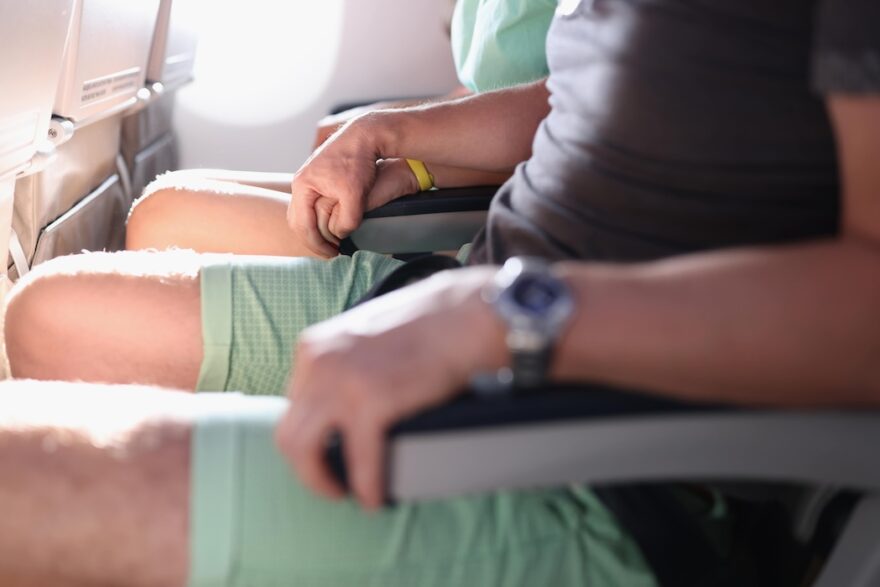How to deal with & overcome turbulence anxiety
Have you ever wondered how to get over fear of turbulence? Read more to find out how.

Do you get nervous during turbulence when flying? It can be quite unsettling, especially if you’re not used to it. Some people find it thrilling, while others feel anxious.
How do you usually cope with those sudden bumps and shakes? Does it affect your comfort during flights?
Knowing how to get over turbulence anxiety can be the difference between a relaxed, enjoyable flight and an unpleasant white-knuckle ride full of turbulence anxiety.
What is fear of turbulence?
The fear of turbulence, often referred to as aerophobia or aviophobia, is a common anxiety among passengers during flights.
Turbulence occurs due to irregular air currents causing an aircraft to experience sudden, unpredictable movements.
While turbulence is generally harmless and poses little risk to the safety of the flight, the sensation of the plane shaking can be deeply unsettling for many.
This fear stems from a lack of control and understanding of what turbulence actually entails.
For some, the unexpected jolts and dips trigger a fear response, imagining worst-case scenarios.
The enclosed space of an aircraft, coupled with the inability to see the cause of the turbulence, exacerbates the feeling of vulnerability.
Physiologically, turbulence can cause symptoms such as sweating, increased heart rate, and shortness of breath, which are typical of anxiety.
Psychologically, it can lead to a heightened sense of dread and panic. Passengers might grip their armrests, close their eyes, or engage in repetitive comforting behaviours to manage their fear.
Does turbulence scare pilots and flight attendants
Understanding that pilots are well-trained to handle turbulence and that modern aircraft are designed to withstand it can help mitigate this fear.
Flight attendants, due to their extensive training and experience, do not get scared by turbulence.
They understand that turbulence is a normal part of flying and poses minimal risk to the aircraft.
Their training equips them to remain calm and focused, ensuring the safety and comfort of passengers during turbulent conditions.
You’ll notice that often the flight attendants continue with their duties as normal, walking around the cabin during turbulence.
On occasions, during severe turbulence they would not experience fear but efficiently remain vigilant and take necessary precautions, such as securing the cabin, stowing away food trays and drinks, and ensuring passengers are safely seated with seatbelts fastened.
This has nothing to do with the aeroplane being in danger – it just prevents passengers from being hurt by spillages or objects falling on them.
Flight attendants are trained to recognise different types of turbulence and respond appropriately. Their calm demeanour and professional handling of such situations help maintain a sense of normalcy and safety on board.
While turbulence is a routine aspect of their job, their primary concern is always the well-being of the passengers and the smooth operation of the flight.
Therefore, their confidence and preparedness play a crucial role in managing any in-flight turbulence effectively.
How to deal with turbulence anxiety
By understanding the facts about it you will find yourself overcoming the fear of turbulence and enjoy flying even in the event of severe turbulence.
-
Knowing how to not be scared of turbulence is key
Dealing with turbulence anxiety involves a combination of mental preparation, practical strategies, and understanding the nature of turbulence.
Here are some tips on how to overcome fear of flying turbulence.
Firstly, educating yourself about turbulence can significantly reduce anxiety.
Knowing that turbulence is a normal and safe part of flying, and that pilots and aircraft are well-equipped to handle it, can provide reassurance.
Some people find it useful to practice relaxation techniques such as deep breathing, meditation, or visualisation.
These methods can help manage anxiety symptoms like increased heart rate and sweating. During the flight, focus on steady, deep breaths to maintain calmness.
Enjoying entertainment such as watching movies, reading, or listening to music helps keep your focus of turbulence.
More importantly, if you can positively think about turbulence, rather than try to ignore it, it really does help remove fear of air turbulence.
-
Making yourself comfortable with a travel pillow or a cozy blanket
It can create a sense of security and it can also be a good idea to inform the flight attendants about your anxiety – they will be sure to provide you with extra reassurance and support, and you may well get spoilt a bit by them too.
-
Cognitive-behavioural techniques
Such as challenging negative thoughts and replacing them with positive affirmations, can alter the way you perceive turbulence.
Remind yourself that turbulence is temporary and that the aircraft is built to withstand it.
Airlines like British Airways also provide courses to help passengers overcome their fear of flying.
Programmes such as the brilliant Allen Carr’s Easyway to Enjoy Flying include some fabulous practical tips as well as furnishing you with all the facts and techniques that you require to not only tolerate turbulence during flights, but to enjoy it.
Ultimately, recognising that turbulence is a routine aspect of air travel that presents little danger can significantly alleviate turbulence anxiety, leading to a comfortable and stress free flying experience.
If you looking for more information, check out our article on how to get over fear of flying and is there a cure for the fear of flying?




